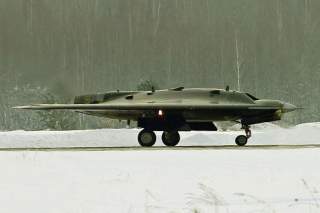Russia's Hunter Drone Has One Major Stealth Problem
Can Russia fix it?
Key point: The Hunter drone has great stealth potential, but part of its engine sticks out.
It appears the Russian warplane-make Sukhoi has a plan to fix the most obvious flaw in the design of its new Hunter drone.
Photos from The War Zone editor Tylor Rogoway obtained from the Sukhoi pavilion at Russia's MAKS air show in Moscow oblast reveal what is apparently the ultimate version of the fighter-style Hunter.
This version features an engine exhaust that is flush with the airframe. The current, prototype version of the Hunter, which first appeared in January 2019, features an AL-31 engine that protrudes from the fuselage.
Such an engine arrangement represents a major source of radar signature and could ruin the drone’s stealthiness from the side and rear aspects.
“So, at the moment, Russia's Hunter design is far from realizing the low-observability it seems to aspire towards, but now we know that Sukhoi is not only aware of this, the company hopes to fix it as the aircraft moves forward in development,” Rogoway wrote.
The new exhaust layout “is most reminiscent of the one found on the X-45A demonstrators that largely paved the way for American [unmanned combat air vehicle] development,” Rogoway pointed out.
It’s unclear whether the new exhaust also will require Sukhoi to install a new engine on the Hunter. A change of powerplant could complicate Russia’s efforts to speed Hunter into front-line service.
But the extra work likely is worth it. A flying wing similar in shape to the U.S. Air Force's B-2 stealth bomber, Hunter, in theory, could penetrate enemy defenses to deliver ordnance. The design greatly would benefit from all-aspect stealth.
In size and shape,Hunter is in the same class as China's Tian Ying drone, the U.S. Air Force's RQ-170 surveillance unmanned aerial vehicle, the U.S. Navy's experimental X-47B UAV and Boeing's X-45C drone demonstrator.
The Chinese drone and the X-47 and X-45 are just demonstrators or prototypes. By contrast, the likelihood of Hunter-B eventually entering squadron service with the Russian air force is "big," Tom Cooper, an independent expert on Russian military aviation, told The National Interest.
"The Russian military is running multiple UAV-related projects," Cooper said. "Thus the emergence of this project is perfectly normal."
On Aug. 3, 2019, a Hunter prototype took off from a military test site for its first-ever test flight. The flying-wing-shape drone flew for more than 20 minutes at a maximum altitude or around 2,000 feet, reported TASS, a state news organization.
The prototype drone also was on the flight line when Russian president Vladimir Putin on May 14, 2019 inspected the country’s latest warplanes at the 929th Chkalov State Flight-Test Center in Russia's Astrakhan region.
“In addition to the modern and advanced military aircraft and helicopters that were shown to us, unmanned aerial vehicles were presented,” Putin said. “I emphasize that all the activities in preparation for the serial production of this technology were performed on time.”
“Let's get to work,” Putin said.
"At this point, it is going to be heaviest and fastest UAV [in Russian service] if and when fielded, but additional testing and evaluation will have to take place in order for this unmanned system to be fully functional,” said Samuel Bendett, an independent expert on the Russian military. “Its speed [up to 620 miles per hour] and weight — up to 20 tons — means that a host of aerodynamic, electronic and high-tech issues need to be worked out."
To be effective in service, Hunter also will need small precision-guided munitions, Cooper pointed out. The Kremlin long has lagged behind the rest of the word in PGM development.
All the above means that Hunter might need several more years of development before it's ready for squadron service.
But Russian crews are already getting ready, Cooper said. "The first generation of pilots and ground crews for UAVs just completed their four-years-long training, and they meanwhile have plenty of experience in operating smaller UAVs in Syria."
This first appeared in August 2019.

